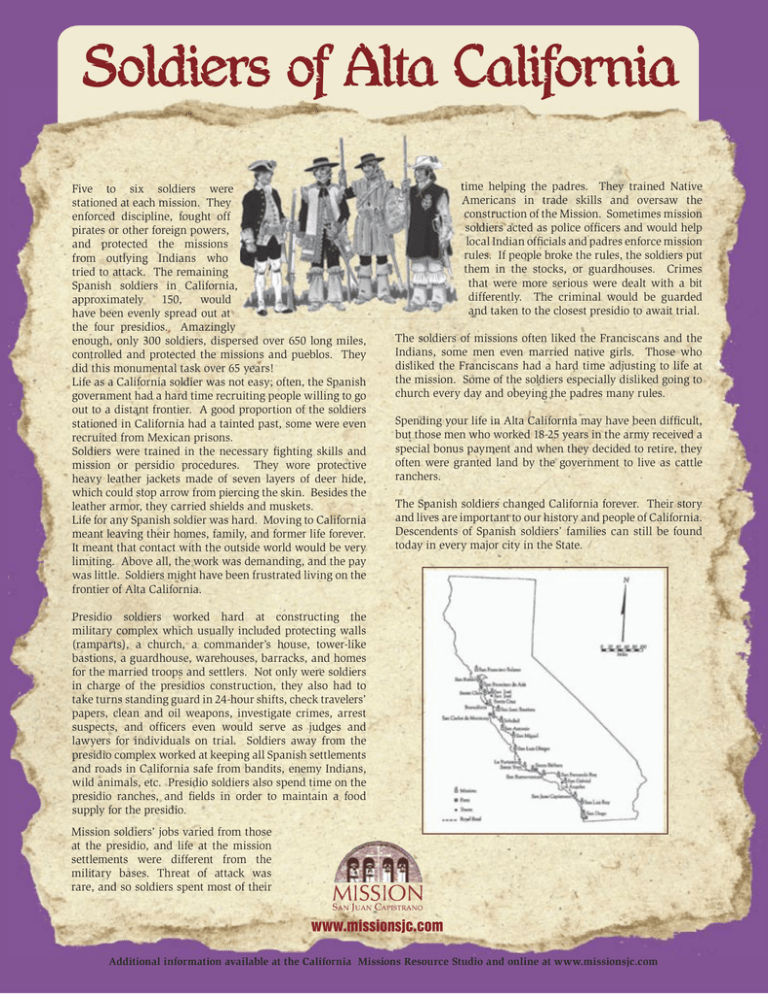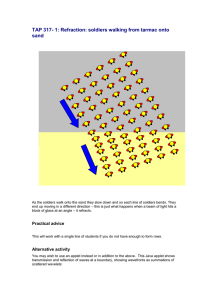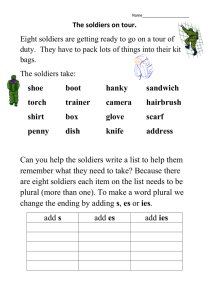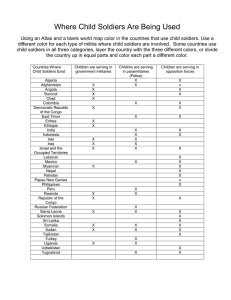Mission CAF pdfsRV3.indd
advertisement

Soldiers of Alta California Five to six soldiers were stationed at each mission. They enforced discipline, fought off pirates or other foreign powers, and protected the missions from outlying Indians who tried to attack. The remaining Spanish soldiers in California, approximately 150, would have been evenly spread out at the four presidios. Amazingly enough, only 300 soldiers, dispersed over 650 long miles, controlled and protected the missions and pueblos. They did this monumental task over 65 years! Life as a California soldier was not easy; often, the Spanish government had a hard time recruiting people willing to go out to a distant frontier. A good proportion of the soldiers stationed in California had a tainted past, some were even recruited from Mexican prisons. Soldiers were trained in the necessary fighting skills and mission or persidio procedures. They wore protective heavy leather jackets made of seven layers of deer hide, which could stop arrow from piercing the skin. Besides the leather armor, they carried shields and muskets. Life for any Spanish soldier was hard. Moving to California meant leaving their homes, family, and former life forever. It meant that contact with the outside world would be very limiting. Above all, the work was demanding, and the pay was little. Soldiers might have been frustrated living on the frontier of Alta California. time helping the padres. They trained Native Americans in trade skills and oversaw the construction of the Mission. Sometimes mission soldiers acted as police officers and would help local Indian officials and padres enforce mission rules. If people broke the rules, the soldiers put them in the stocks, or guardhouses. Crimes that were more serious were dealt with a bit differently. The criminal would be guarded and taken to the closest presidio to await trial. The soldiers of missions often liked the Franciscans and the Indians, some men even married native girls. Those who disliked the Franciscans had a hard time adjusting to life at the mission. Some of the soldiers especially disliked going to church every day and obeying the padres many rules. Spending your life in Alta California may have been difficult, but those men who worked 18-25 years in the army received a special bonus payment and when they decided to retire, they often were granted land by the government to live as cattle ranchers. The Spanish soldiers changed California forever. Their story and lives are important to our history and people of California. Descendents of Spanish soldiers’ families can still be found today in every major city in the State. Presidio soldiers worked hard at constructing the military complex which usually included protecting walls (ramparts), a church, a commander’s house, tower-like bastions, a guardhouse, warehouses, barracks, and homes for the married troops and settlers. Not only were soldiers in charge of the presidios construction, they also had to take turns standing guard in 24-hour shifts, check travelers’ papers, clean and oil weapons, investigate crimes, arrest suspects, and officers even would serve as judges and lawyers for individuals on trial. Soldiers away from the presidio complex worked at keeping all Spanish settlements and roads in California safe from bandits, enemy Indians, wild animals, etc. Presidio soldiers also spend time on the presidio ranches, and fields in order to maintain a food supply for the presidio. Mission soldiers’ jobs varied from those at the presidio, and life at the mission settlements were different from the military bases. Threat of attack was rare, and so soldiers spent most of their www.missionsjc.com Additional information available at the California Missions Resource Studio and online at www.missionsjc.com



